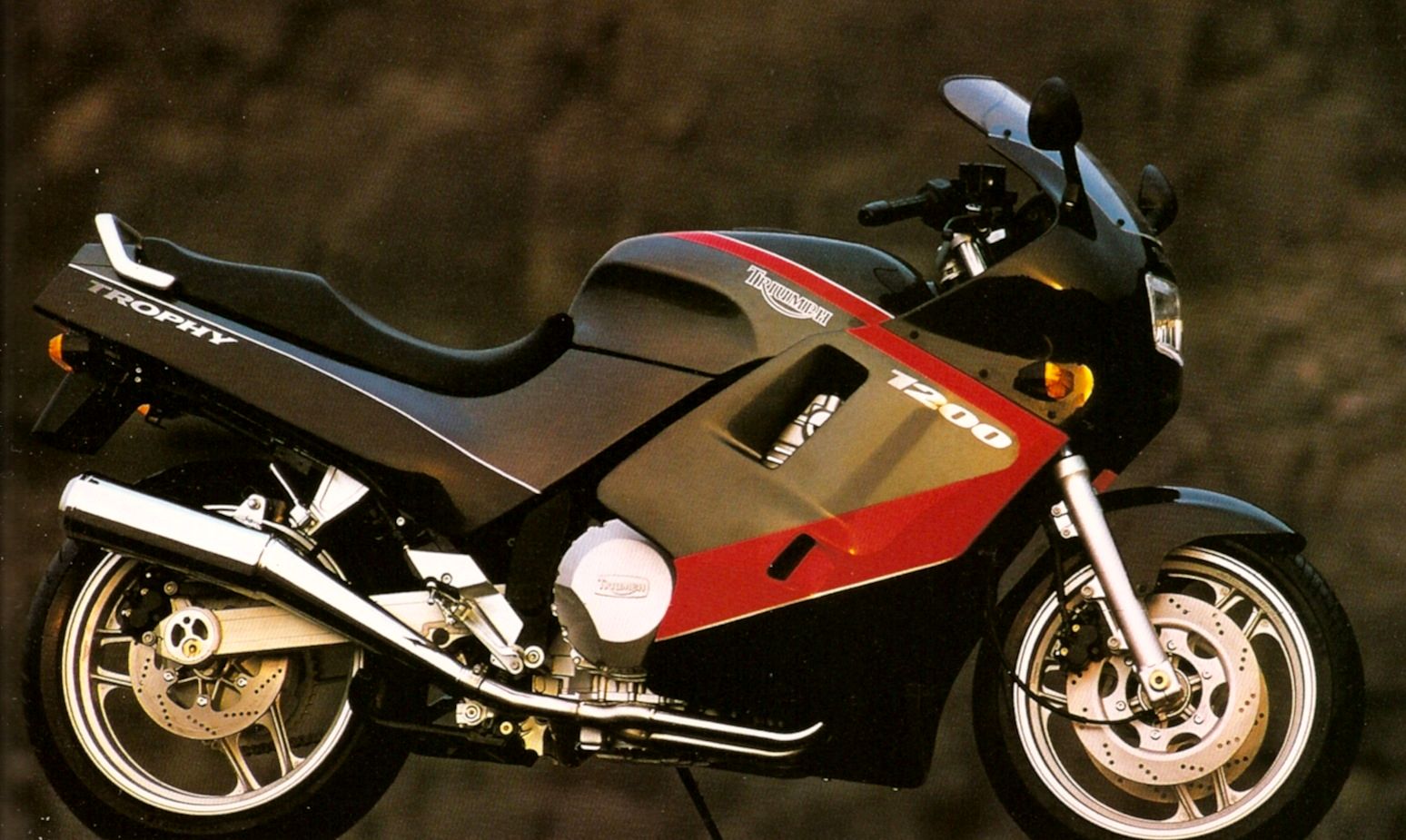When the Trophy 1200 hit the roads in 1991, it was a surprise to just about everybody. Part of the surprise was left over from the astonishment of the Cologne Motorcycle Show in September 1990, six months earlier.
 |
| Pre-production Trophy 1200 as Exhibited at the Septermber 1990 Cologne Motorcycle Show |
The paint and graphics for all models were revised following comments from show visitors and potential customers to the form they would retain until 1993.
Journalists struggled to believe it wasn't just another myth or financial stitch up, that the motor would stay together without leaking oil, that there would be any engine-chassis combination that could work in a satisfactory way. There was a huge credibility gap for John Bloor and the likes of Bruno Tagliaferi and Gary MacDonald to fill.
The Daytona 1000 received a tepid response from the press at the time, though the passage of time allows a more sympathetic understanding of its virtues than the super-sports image permitted bay then. The Trophy 1200 amazed just about all the journalists who wrote about it for the urge available from its engine, positive and stable ride quality and general standard of finish.The Trophy 1200 filled the gap in a way that did proper service to all their careful planning, designing and development work. Inevitably, when looking back at journalists' statements about relative power twenty years ago, some read now as pure hyperbole couched in terms of the expectations of the day. Gazelles also may have moved differently in the early 1990s. However, the excitement and balance of the package are as clear now as they were then.
The Daytona 1000 received a tepid response from the press at the time, though the passage of time allows a more sympathetic understanding of its virtues than the super-sports image permitted bay then. The Trophy 1200 amazed just about all the journalists who wrote about it for the urge available from its engine, positive and stable ride quality and general standard of finish.The Trophy 1200 filled the gap in a way that did proper service to all their careful planning, designing and development work. Inevitably, when looking back at journalists' statements about relative power twenty years ago, some read now as pure hyperbole couched in terms of the expectations of the day. Gazelles also may have moved differently in the early 1990s. However, the excitement and balance of the package are as clear now as they were then.
Motorcycle News, March 1991:
"Since the engine is the most demanding piece of engineering in a motorcycle, the brilliance of the 1200 comes as the biggest shock. Power is everywhere ... at low rpm the sense of latent power is colossal, there's never any need to wait for the motor to gather is forces. ... The motor has more grunt than a charging rhino on speed but the chassis and tyres give the agility of a gazelle - an almost magical combination still rare even in todays' high-tech bike industry, and unheard of in connections with any british roadster."
Bike Magazine, May 1991:
"From 4000rpm, there's phenomenal, exhilarating urge that, thanks to the pari of gear-driven balance shafts in the sump, is honey-smooth up to 6000rpm, an id growls through its Motad stainless four-int-two pipes beyond that. A fearsome growl like no other. ... Taking the package as a whole, the plusses are massive and reek of well thought-out professionalism. ... It's not at the cutting edge of technology, there's no gimmicks, no upside-down forks and no fancy aerodynamics. But it is a damn fine bike powered by an astonishingly lusty, zestful engine."
Fast Bikes, June 1991
"Triumph motorcycle company have produced a bike that is not just good, it ... may be the best sports-tourer ever. [it has] a mighty furnace of free-flowing, unending power that pours forth with the continuity and inexorability of molten steel ... It hauls you to 100 on the merest tug of the throttle where the crank is spinning at a lowly six grand, yet it can pull away in top from the hundreds and fill its lungs as quickly over three figures as it does when you let the remarkably precise and glitch-free clutch out at a trickles. 'Torque-line' may be more appropriate than torque curve, as it just keeps on getting stronger all the way from 4000rpm to 8000rpm with no perceptible peaks or troughs. ... There is an almost perfect harmony of stance with the level of rake afforded by the screen an d fairing an d the Trophy is as capable of devouring peaceful, angst-free miles as any of the standards of sports-tourers."
A year or so later, the factory had gained confidence and was prepared to make bold statements about what it was about, where it had come from, and the values that would carry it forward. The Building on a Heritage video shows that Triumph still had a job to convince people they were for real. The format and accent of the narrator also shows how long ago it is now that this resurgence happened, underlining the historical significance of the relaunch in its own special way.
"The public at large could be excused for not appreciating that the current range of Triumph motorcycles was conceived, designed and manufactured in Britain. What also gets overlooked is the fact that it was the result of a decade of painstaking research design and development, building on a heritage."



No comments:
Post a Comment